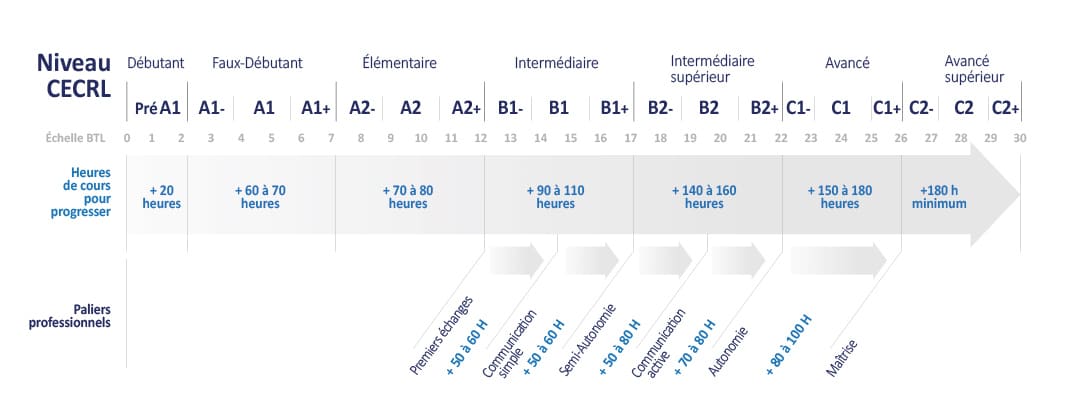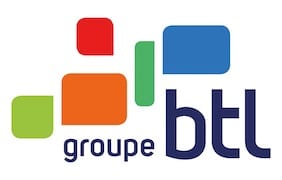What are the fundamentals of teaching a foreign language?
Whether face-to-face or distance learning, one-to-one or group classes, the effectiveness of our courses is based on the fundamental principles of language teaching :
- the quality of the teacher
- true consideration of the learner's needs by offering a tailor-made learning programme
- independent selection of the best teaching resources
- pedagogical and administrative support throughout the course
But beyond these essentials, it's our communicative and contextualized approach that enables you to reach your goals.
As such, the learner plays an active role from the outset, developing the communication skills needed to carry out their activities in a foreign language: collaborating internationally, negotiating with suppliers, finding technical solutions, giving a presentation in another language...
Concrete results for better performance at work
Excellent training, I saw a real difference between the start and the end of the course in terms of the fluency of our conversations. I've regained my confidence and my language level has improved.
The trainers were remarkable in their responsiveness, attentiveness and teaching skills.
Great training, the teacher always listened to my needs and explained the grammatical basics. I really enjoyed my 20 hours with her. I recommend 1000%.
My teacher capably adapted her methods to my level and my needs. I progressed much faster than I had imagined. Thanks to her effective teaching methods, I've gained a lot of self-confidence.
Our teacher was very professional, full of joy and pedagogy. The sessions were varied and full of energy, which improved my speaking and writing skills.
The benefits of a dedicated teacher who continuously adapts their approach throughout the course
We favour having a single teacher for each language course, so that we can:
- establish a relationship of trust between learner and teacher
- adapt the approach and content to the learner's progress, strengths and weaknesses
- get to know the learner really well, enabling us to better tailor the course to their needs
- optimal follow-up of consolidation work requested by the trainer and carried out by the learner
- challenge learners' understanding of different accents with the use of audio and video clips
He's just the best teacher! His teaching methods are perfect, and he makes you want to excel.
The results you can expect from our language teaching
Together with each individual, we define their training objectives, based on an in-depth audit of their needs. Then, a stimulating educational program is put together to target these same objectives as effectively as possible. Depending on the targeted objectives, at the end of its customized program with BTL the learner may be able to:
- Express yourself with greater ease on professional subjects: in interviews, meetings, on the phone...
- Better handle phone calls, conferences, meetings, presentations...
- Better understand emails, articles and/or professional documents
- Improve their professional writing
- Use a more varied and relevant professional and socio-professional lexicon
- Use more complex grammatical structures with fewer mistakes
The CEFR scale
BTL's expert assessors are qualified to position learners on the CEFR. All our courses, curricula and course materials are defined according to their CEFR level. At the end of the course, each learner receives a final report indicating his or her new level on this scale. This enables us to distinguish more developed skills from those requiring additional training (oral or written expression or comprehension, vocabulary, etc.). Find out more >

Which format would suit your employees?
Customize your training program with our comprehensive catalog of options. We'll guide you in your choice of training methods:
- Private lessons or in small groups ?
- Visit In person on your premises or via videoconferencing?
- Weekly sessions or intensive courses?
- With Blended Learning integrated or not?
While the choice of modalities that make up your course package allows you to adapt the practical aspects to your pace of life and learning style, we also offer a choice of language orientations. Training focused on general professional language includes transferable skills such as presentations, telephone calls and vocabulary common to most sectors and professions. On the other hand, training focused on sector-specific language allows you to dedicate a third of the course to technical vocabulary and issues in your specific field. Or alternatively, the pedagogical program of a customized language course is created from scratch in response to a specific customer need. Discover our training programs >
How do we teach language?
Our memory anchoring techniques enable you to integrate what you've learned in a lasting way.
Our teaching approach is based on learning how to communicate effectively as quickly as possible, thanks to the " three Ps " : Presentation, Practice and Production.
What role does digital technology play in foreign language learning?
At BTL, we believe that innovation in language learning lies in the way digital tools are used, not necessarily in the tools themselves. Digital technology becomes a powerful lever for pedagogy when resources are selected and integrated in a targeted way by a pedagogical expert, according to the specific needs of each learner.
Each training course is tailor-made, with adapted use of technology to combine the best of digital technology and human interaction. With this in mind, digital becomes a means of enriching learning by offering a range of interactive and dynamic content: interactive modules, multimedia resources, exchange platforms... The aim is to reinforce learning while taking advantage of the unique support and guidance of teaching experts to maximize the impact of each session.
How can you accelerate the learning process while keeping your budget under control?
Visit Blended Learning is the ideal combination of instructor-led courses and self-guided e-learning. With unlimited access to the e-learning platform for the duration of their training, learners can accelerate their skills development as much as they wish.
Do you need an independent language certificate, such as the TOEIC test?
BTL is authorized to have your employees sit an independent, internationally recognized test or examination, eligible for the CPF. This enables you to standardize the assessment of your employees' language levels, who are evaluated using the same framework and receive a certificate attesting to their level. What's more, an independent test enables any professional to enhance their profile with a recognized certificate. BTL has been a TOEIC agent for some fifteen years, as well as a CLOE, BRIGHT and LILATE agent, among others.




